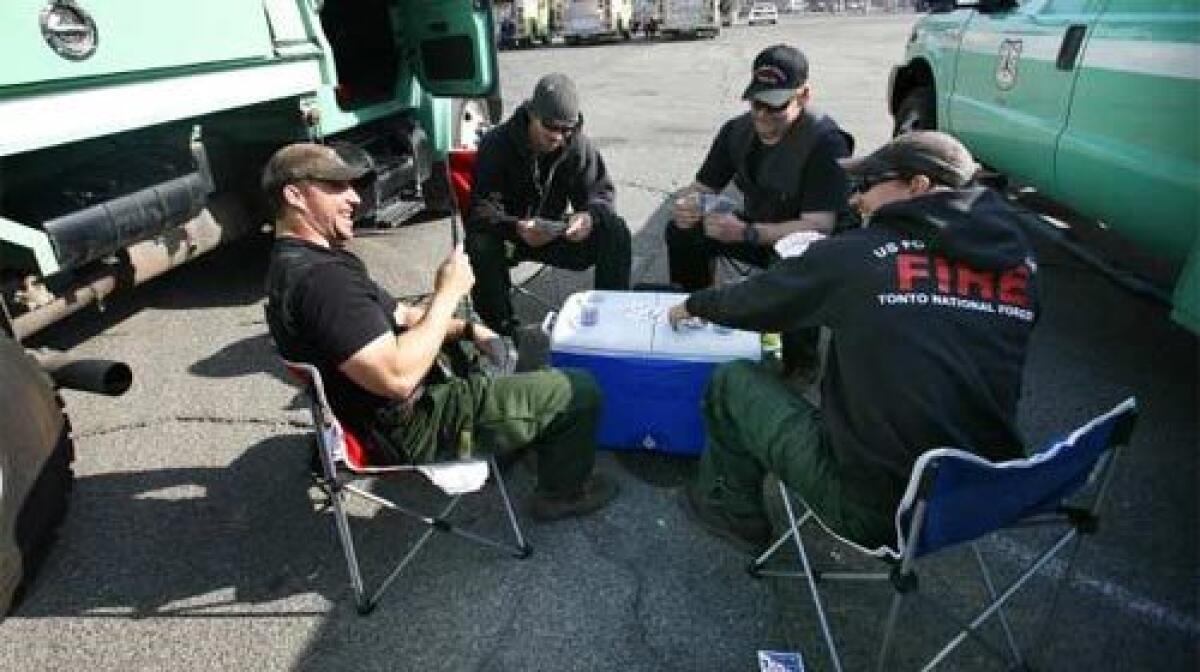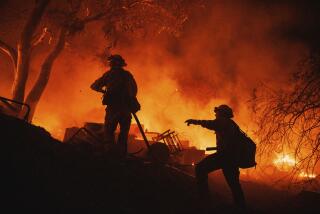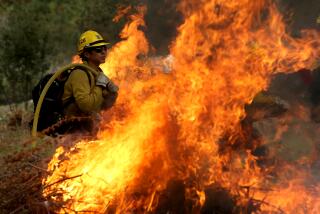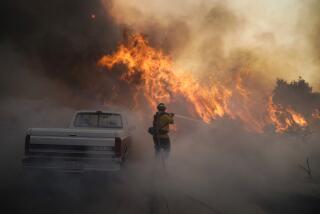Firefighters spend holiday waiting in San Bernardino

Once upon a time, Justin Hardison could plan on a three-month firefighting season. It never crossed his mind that he might not spend Thanksgiving at home in Lolo, Mont.
But a few days ago, Hardison and firefighters Jeff Stabio and Doug Knight got a call. Santa Ana winds were kicking up in Southern California, and they were needed -- again.
The three had fought the wildfires here a month ago.
They packed their gear and spent most of three days driving. They arrived Monday, not looking forward to a Thanksgiving spent on the oil-stained asphalt parking lot of the National Orange Show Grounds in San Bernardino.
Within miles was the San Bernardino National Forest -- one of the most urbanized forests in America.
Thanksgiving marked the latest point in the year that Hardison had been called out in his eight years as a part-time firefighter, and the trip meant his 2007 fire season would run for six months.
“I can’t say if this is going to be the pattern,” said Hardison, who works for A-1 Fire Service, a private wildland firefighting company in Lolo, a suburb of Missoula.
But “conditions are getting worse and worse. Things are getting hotter and drier,” he added.
The guys from A-1 joined hundreds of others from across the Western United States who gave up their holiday to assemble to protect Southern California in case of fire.
Despite early morning fog, forecasts called for low humidity and gusting winds of up to 45 mph for today and Saturday.
So, stung by the raging wildfires of October, regional fire officials this week called down more firefighters and engines than they could confidently count Thursday, spreading them from San Diego to Ventura counties.
One big concentration was at the show grounds.
Resembling a tribal assembly, more than 300 firefighters came from across the West, trim and rugged, many with sunglasses perched on baseball caps, their department names and insignia across blue T-shirts.
They threw footballs and watched football on TV, they played cards and they planned strategy in a language all their own.
Mostly, though, they waited.
They lined their 62 engines, six bulldozers and nine water tenders in formation across the parking lot in a mobilization that included food, cots, toilets, showers, a medical clinic, an auto shop, a chainsaw-sharpening shop and television screens.
“It’s a mix between an Arabic bazaar, a county fair and a family reunion,” said Jim Wilkins, the San Bernardino operations center spokesman.
Firefighters came in from Mount Lemmon and the Groom Creek Fire District in Arizona; from Upper Pine River in Colorado; and from Fort Bragg and Oakdale, Calif.
The Zuni Hotshots, legendary Indian fire-line cutters, came in from New Mexico.
But the farthest-flung contingent was five engines from companies across Montana.
Urban firefighters are used to working at least one important holiday a year.
But for many wildland firefighters, particularly in Montana, a Thanksgiving workday is a new experience.
However, Southern California has had little rain in two years. These days, the region almost never goes out of fire season, Wilkins said.
Hardison and the rest had never been to California until the last year, during which they’ve come down three times.
Indeed, this gypsy life is increasingly how things are for wildland firefighters: going from fire to fire across the West in seasons that don’t promise to get shorter.
“It’s a lifestyle,” Hardison said. “It’s not for everybody. I couldn’t see a marriage surviving doing this, though I know there are guys who do it.”
Hardison’s daughter has a birthday Dec. 1. “I’m really hoping I’ll be back. She’ll be 4,” he said.
Not far away, Shawn Prociv and Jon Hauge, both from the Three Trees Construction Co., a private firefighting company in Browning, Mont., lounged against their engine in the November sun that eventually took temperatures to a high of 70 degrees.
“The seasons aren’t the seasons no more,” Prociv said. “The earth is changing. We’ve got to change with it.”
Both men sense fire seasons may be lengthening.
“This is the first time that I’ve seen it go this deep into the year,” said Hauge, 36, who noted that a 7,500-acre fire was also raging uncontained in Arizona.
Prociv is a Blackfoot Indian. Historically, the Blackfoot used fire in healthy ways, such as to rejuvenate a prairie, Prociv said.
Today, though, fire tends to have a more ominous feel of pure destruction.
In Southern California, “it appears we’re burning more, we’re burning hotter, we’re burning faster,” Wilkins said.
One effect, he said, is that fire at times sterilizes a wildland area, keeping native plants from growing back and providing open space for invasive plants that quickly take an area over.
Also, developments in forest and rangeland, with houses that seem made to burn, have added to the frequency and destructive force of fire.
Furthermore, Hardison said, fires have been fought so aggressively in the past that in some wilderness areas fuel is prevented from burning off and dense brush has built up, making fires much harder to stop when they happen.
All of which is say that, no matter what happens this week, to the folks congregating at the show grounds during Thanksgiving, a bit of firefighter wisdom seemed timely.
“If man doesn’t take care of an area,” Hauge said, “fire will.”
sam.quinones@.latimes.com
More to Read
Start your day right
Sign up for Essential California for news, features and recommendations from the L.A. Times and beyond in your inbox six days a week.
You may occasionally receive promotional content from the Los Angeles Times.






